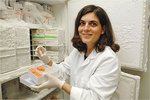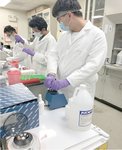

As cases of coronavirus in Ingham county began to wane in June, Michigan State University researcher Joan Rose noticed a sudden uptick in the amount of coronavirus in campus and Meridian Township wastewater. Without many students on campus, the news was puzzling.
“We started monitoring the wastewater on campus, and there weren’t very many students in the dorms.” Rose explained. “It was kind of bouncing around, but pretty low, around the detection limit. Sometimes it was negative. Sometimes we’d see a little positive. We saw this huge peak in June, and I’m like, ‘What is this?’ It’s orders of magnitude larger than what we’d been seeing.”
Later, Rose learned it was the start of an outbreak tied to Harper’s Restaurant and Brew Pub.
The wastewater research efforts are steered by Rose’s graduate students who wanted to search for COVID-19 in wastewater. The idea is based on research that shows those infected with the virus shed it in a variety of bodily functions — including urine and feces. And detecting the virus in the wastewater early can help health officials track where the virus is spreading.
“People release viruses through urine and feces and then other secretions of the body like in our mucus, different parts of the body,” said Irene Xagoraraki, associate professor of civil and environmental engineering. “You see, it’s not just the toilet. It’s just when we wash our hands, when we take a shower. So, all the bodily secretions, they end up in the collection system.”
All of that water — from the toilet, the sink, the shower — flows into hundreds of thousands of miles of underground sewer pipelines. Those lines then feed into water treatment facilities, where the water is cleansed of much of the waste, and then released back into nature.
The problem with looking for viruses in a slurry of wastewater, however, is separating the viruses from the mixture in the first place. Rose and others used a technique of a positively charged screen, much like a net if you will, that attracts and captures the viruses.
Then, scientists use a process known as PCR — or polymerase chain reaction — that looks for specific genetic material related to specific viruses. That allows researchers to determine what viruses are present and in what quantities, a valuable tool in quantifying COVID-19 in Michigan.
The state of Michigan is also hoping wastewater monitoring will help in the public health process. It provided about $1.3 million to fund Rose’s work, training and assisting staff at 20 advanced PCR laboratories across Michigan and offering advanced analytical techniques.
More than 100 wastewater locations will be monitored for the SARS-CoV-2 virus to provide early warning and to assist local health departments in implementing public health measures to prevent the spread of the virus — particularly to sensitive populations where the virus is found.
Rose has been working for years to remove viruses from wastewater releases. Her Ph.D. work was in Mexico, looking at various wastewater and enteric, or gut-related viruses. Xagoraraki received $800,000 to continue her work on viral infections in the Detroit sewage system.
Those studies have resulted in the identification of correlation between the HIV pandemic in Detroit and a herpes virus that causes a skin cancer called Kaposi’s Sarcoma, Xagoraki said.
That money ran out last December, stalling her studies for coronavirus in the Detroit sewers until April — more than a month after the first COVID-19 case was detected in Michigan.
“We’re able to capture the second and third waves about three to four weeks ahead of time,” she said.
Capturing the increases in viral transmission is important, she said, because it can inform public health officials and hospitals on where and when a new surge is going to emerge more broadly. It also provides an opportunity to communicate with communities most impacted by COVID-19.
“Our early work confirmed the validity of the method to provide early warning of multiple viral diseases, including hepatitis and COVID-19,” Xagoraraki said. “The Detroit project goes above and beyond simple testing of wastewater. We include multiple other data, measurements, and processes to provide a tool that can be used by public health officials.”
Support City Pulse - Donate Today!
Other items that may interest you

Comments
No comments on this item Please log in to comment by clicking here